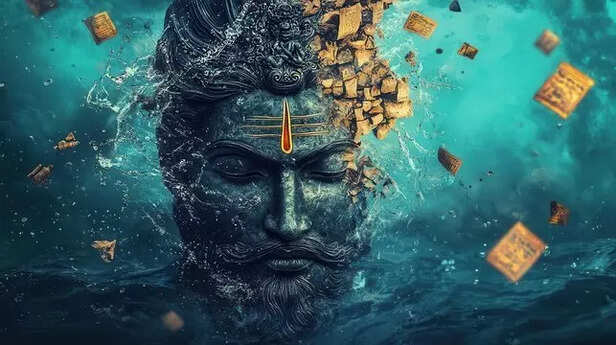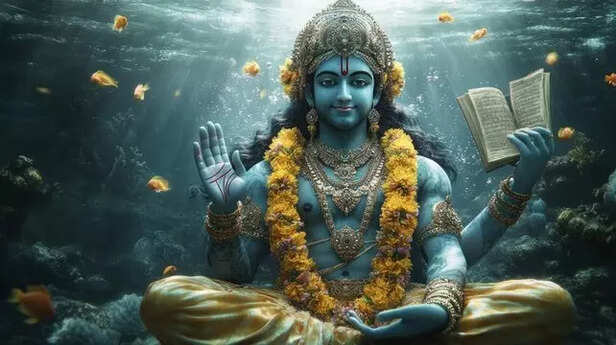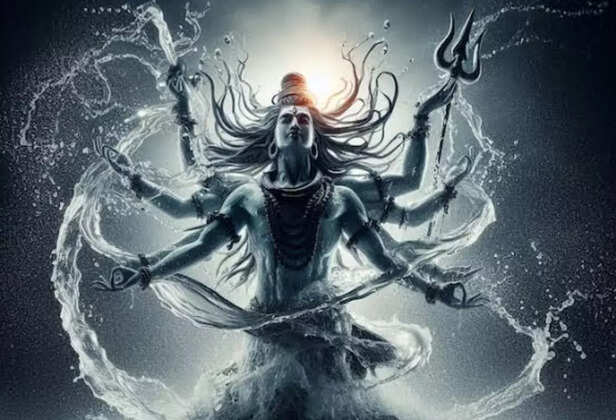Matsya & Manu—Vishnu's First Avatar, the Cosmic Flood, and the Rebirth of Humanity
Ankit Gupta | Jun 11, 2025, 23:59 IST
Long before the biblical tale of Noah’s Ark, ancient Hindu scriptures described a cosmic flood—not merely of water, but of illusion. In this profound myth from the Srimad Bhagavatam, Lord Vishnu appears as a small, speaking fish to Manu—the first human and the embodiment of higher consciousness. As the fish grows, it reveals its divine identity and warns Manu of an impending Pralaya (cosmic dissolution). Guided by the divine, Manu builds a boat, gathers seeds, sages, and sacred wisdom, and ties the vessel to Matsya’s horn using the serpent Vasuki.
“Long before Noah, Hindu texts spoke of a great flood – not just of water, but of illusion. Only one man listened... and one divine fish came to guide him.”
The story begins, not with thunder or destruction, but with silence. It was during the twilight hours of a solemn Vedic ritual that Manu, the progenitor of mankind, cupped his hands to offer arghya (water) to the gods. But within that sacred flow, a tiny fish appeared, shimmering with mysterious brilliance. The fish pleaded:
"Protect me, O noble one, from the bigger fish. I am small and weak."
Compassion moved Manu’s heart. He placed the fish in a small jar. But overnight, the fish grew. Transferred to a tank, then a pond, and eventually a lake, it continued growing. Realizing something divine was at play, Manu finally released it into the ocean. There, the fish transformed—its body spanned the horizon, glowing with cosmic radiance. From its mouth came a voice:
"I am Vishnu. I have come in the form of Matsya – the Fish Avatar. A great deluge will soon consume the world. But you, O wise Manu, have been chosen to preserve life."
Thus began the saga of Matsya and Manu – the eternal story of destruction and rebirth, of cosmic floods and inner awakenings.

The Hindu concept of time is not linear but cyclical. The universe is born, sustained, destroyed, and reborn again—Srishti (creation), Sthiti (preservation), Samhara (dissolution). The flood, or Pralaya, is the moment of dissolution when all names, forms, and egos are washed away into the infinite ocean of existence.
In the Srimad Bhagavatam (8.24.10–14), Lord Vishnu tells Manu:
"Build a boat. Take with you the seven great sages (Saptarishis), seeds of all plants, pairs of every living being, and sacred texts. When the flood rises, I shall appear once again as a giant fish. Tie your boat to my horn using the serpent Vasuki, and I will guide you through the waters."
This is not just mythology—it’s metaphysics. The deluge is not merely water; it is illusion (Maya). It is the collapse of false identities, material attachments, and the ego. And the boat? That’s your Sādhanā—the spiritual discipline that keeps you afloat when the world crumbles.
Who is Manu?
In Hindu scriptures, Manu is the first human, the lawgiver (Manusmriti), the progenitor, and the one who survives the deluge. But beyond that, he is symbolic of something deeper:
This ancient tale is layered with symbolic meaning:
At first, the divine is subtle. Like the fish, it appears small—easily ignored. But when nurtured through shraddha (faith) and bhakti (devotion), it expands, consuming our limited perspectives and revealing its true divine form.
Matsya is the grace that appears first as intuition, then grows into spiritual wisdom, and finally becomes the guru guiding the seeker through the storm.
The cosmic flood is not just the end of the world—it is the end of your false self.
In meditation, when thoughts dissolve, when attachments crash, when the familiar sinks—that is Pralaya. And it is terrifying. But necessary. For only when the old dies can the new be born.
Just as the flood washes away civilizations, in sādhanā, the mind is washed clean. What survives is what is essential, eternal, and true.
Your boat is built not of wood, but of discipline, devotion, and dharma.
When life is chaotic, it is your inner practices—japa, dhyāna, satya—that carry you across. Without the boat, you drown. Without Matsya, you drift.
But with both—you transcend.
Vasuki, the serpent used as a rope to tie the boat to the fish, represents Kundalini, the coiled serpent-energy, and also Time, which binds us to cycles. But when offered in surrender to the Divine, even time becomes a path to liberation.

It is striking that almost every ancient culture speaks of a great flood:
Yet unlike the others, Hindu cosmology doesn't just focus on punishment. The deluge is not vengeance—it is a reset, part of a cyclical process of cleansing and renewal.
And unlike Noah, who is commanded by an external God, Manu recognizes the divine through compassion, through dharma. He listens to a whisper where others see nothing. That’s the mark of a true seeker.

As the flood recedes, the boat lands on the peak of Mount Himavat. From this sacred mountain, Manu and the sages begin repopulating the Earth, using the seeds they preserved, the wisdom they carried, and the discipline they never abandoned.
This echoes the timeless Hindu vision that after every destruction, there is a dawn, and the one who survives it is the one who listens, who nurtures the divine within, and who walks the path of Dharma even in darkness.
As Krishna says in the Gita:
“Whenever there is decline in righteousness and rise in unrighteousness, I manifest myself, age after age.”
(Bhagavad Gita 4.7)
Matsya was the first such appearance. Not to wage war. But to guide a man, a boat, and a dream across the ocean of chaos.
The story of Matsya and Manu is an eternal metaphor:
“As the fish grows when protected, so too does divine wisdom. As the flood comes, so must the ego die. And as Manu survived, so can you.”
The story begins, not with thunder or destruction, but with silence. It was during the twilight hours of a solemn Vedic ritual that Manu, the progenitor of mankind, cupped his hands to offer arghya (water) to the gods. But within that sacred flow, a tiny fish appeared, shimmering with mysterious brilliance. The fish pleaded:
"Protect me, O noble one, from the bigger fish. I am small and weak."
Compassion moved Manu’s heart. He placed the fish in a small jar. But overnight, the fish grew. Transferred to a tank, then a pond, and eventually a lake, it continued growing. Realizing something divine was at play, Manu finally released it into the ocean. There, the fish transformed—its body spanned the horizon, glowing with cosmic radiance. From its mouth came a voice:
"I am Vishnu. I have come in the form of Matsya – the Fish Avatar. A great deluge will soon consume the world. But you, O wise Manu, have been chosen to preserve life."
Thus began the saga of Matsya and Manu – the eternal story of destruction and rebirth, of cosmic floods and inner awakenings.
Pralaya and the Cycles of Time

A Flood Foretold
( Image credit : Freepik )
The Hindu concept of time is not linear but cyclical. The universe is born, sustained, destroyed, and reborn again—Srishti (creation), Sthiti (preservation), Samhara (dissolution). The flood, or Pralaya, is the moment of dissolution when all names, forms, and egos are washed away into the infinite ocean of existence.
In the Srimad Bhagavatam (8.24.10–14), Lord Vishnu tells Manu:
"Build a boat. Take with you the seven great sages (Saptarishis), seeds of all plants, pairs of every living being, and sacred texts. When the flood rises, I shall appear once again as a giant fish. Tie your boat to my horn using the serpent Vasuki, and I will guide you through the waters."
This is not just mythology—it’s metaphysics. The deluge is not merely water; it is illusion (Maya). It is the collapse of false identities, material attachments, and the ego. And the boat? That’s your Sādhanā—the spiritual discipline that keeps you afloat when the world crumbles.
Manu: The Archetype of Consciousness
In Hindu scriptures, Manu is the first human, the lawgiver (Manusmriti), the progenitor, and the one who survives the deluge. But beyond that, he is symbolic of something deeper:
- Manu = Higher Mind / Pure Consciousness
- He is not ordinary. He listens when others don’t.
- He sees a divine spark in a helpless fish.
- He is the vessel of divine will, the anchor of Dharma in a world heading for chaos.
Symbolism of the Fish, the Boat, and the Flood
Matsya (The Fish) = Divine Consciousness
Matsya is the grace that appears first as intuition, then grows into spiritual wisdom, and finally becomes the guru guiding the seeker through the storm.
The Flood = Ego Death / Inner Pralaya
In meditation, when thoughts dissolve, when attachments crash, when the familiar sinks—that is Pralaya. And it is terrifying. But necessary. For only when the old dies can the new be born.
Just as the flood washes away civilizations, in sādhanā, the mind is washed clean. What survives is what is essential, eternal, and true.
The Boat = Inner Sādhanā / Dharma
When life is chaotic, it is your inner practices—japa, dhyāna, satya—that carry you across. Without the boat, you drown. Without Matsya, you drift.
But with both—you transcend.
Vasuki = Life Force / Serpent of Time
Echoes Across Cultures

The Flood Myth Universality
( Image credit : Freepik )
It is striking that almost every ancient culture speaks of a great flood:
- In Genesis, Noah builds an ark to survive God’s wrath.
- In Sumerian myth, Ziusudra or Utnapishtim survives a divine deluge.
- In Greek tales, Deucalion and Pyrrha repopulate the Earth after a flood sent by Zeus.
Yet unlike the others, Hindu cosmology doesn't just focus on punishment. The deluge is not vengeance—it is a reset, part of a cyclical process of cleansing and renewal.
And unlike Noah, who is commanded by an external God, Manu recognizes the divine through compassion, through dharma. He listens to a whisper where others see nothing. That’s the mark of a true seeker.
The End That Begins Anew

From Destruction to Rebirth
( Image credit : Freepik )
As the flood recedes, the boat lands on the peak of Mount Himavat. From this sacred mountain, Manu and the sages begin repopulating the Earth, using the seeds they preserved, the wisdom they carried, and the discipline they never abandoned.
This echoes the timeless Hindu vision that after every destruction, there is a dawn, and the one who survives it is the one who listens, who nurtures the divine within, and who walks the path of Dharma even in darkness.
As Krishna says in the Gita:
“Whenever there is decline in righteousness and rise in unrighteousness, I manifest myself, age after age.”
(Bhagavad Gita 4.7)
Matsya was the first such appearance. Not to wage war. But to guide a man, a boat, and a dream across the ocean of chaos.
The Fish Still Speaks
- Your inner fish is waiting to be noticed.
- Your life may soon (or already) be in flood.
- Your boat is ready—if you choose to build it.
“As the fish grows when protected, so too does divine wisdom. As the flood comes, so must the ego die. And as Manu survived, so can you.”
